Hyundai Tucson Active X v Kia Sportage SLi v Mazda CX-5 Maxx Sport

By: Mike Costello
Mid-sized SUV sales are growing more rapidly in Australia than any other vehicle type, and the two class benchmarks based on our testing to date are the Hyundai Tucson and Mazda CX-5.
Proving, in this case at least, that our testing aligns with actual car buyers, this pair are also topping the sales charts in their segment so far in 2016. But both have a new enemy to contend with that, on paper, stacks up very well indeed.
Said enemy is the all-new Kia Sportage, which launched earlier this year to extremely positive reviews. It wraps its underpinnings in an edgier design to its South Korean sibling from Hyundai, and offers superior aftersales care.

The reality is, though, you couldn’t find a more similar trio of cars. The CX-5, Tucson and Sportage are all but identical in terms of drivetrains, dimensions and capabilities. And all three will be cross-shopped relentlessly.
We’ve chosen to test each in low-grade (but not base) specification, with entry petrol engines, automatic transmissions and front-wheel drive. This is the ‘sweet spot’ in the class, the box a significant number of people tick.
And so the breakdown is: Hyundai Tucson Active X v Kia Sportage SLi v Mazda CX-5 Maxx Sport. Which is best?

Price and equipment
The cheapest car here is the Mazda, at $32,790 (before on-road costs). This undercuts the Tucson at $32,990 and the Sportage at $33,990.The commonality in specification is marked. Each car here gets a 7.0-inch screen, USB/Bluetooth connectivity, cruise control, a reverse-view camera, automatic headlights and six airbags.
But there are differences. The two South Koreans (Hyundai and Kia) get 18-inch alloy wheels with full-size spare wheels, while the Mazda gets 17s with a temporary spare. The Hyundai and Kia also get leather seats over the Mazda’s cloth upholstery, which is a big tick for parents, and electric-folding mirrors.

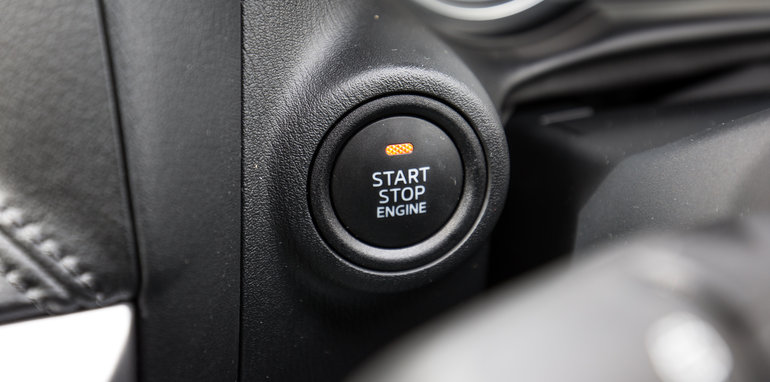
Pictured above: Kia Sportage (top). Mazda CX-5 (below).
The Mazda is also the only car without parking sensors, with the Kia getting front and rear units and the Hyundai getting them at the rear. The Mazda is, finally, the only car here without daytime running lights. The Mazda is, however, the only car here with push-button keyless start.
The Tucson alone misses out on climate control air conditioning (it has a manual setup instead), rear privacy glass and rain-sensing wipers. It also lacks satellite navigation, unlike the other pair, though at present it’s the only one with Apple CarPlay and Android Auto (the Kia gets it in the second half of 2016 as part of a software update). Therefore you have maps, albeit ones that rely on data.
As the newest car here, the Sportage misses out on nothing here, except for the aforementioned keyless start. It is also the only car with a standard electro-chromatic (auto-dimming) rear-view mirror.


Pictured above: Hyundai Tucson (top). Kia Sportage (below).
But it’s not necessarily a win for the Kia. First, it costs $1000 more than the Hyundai and $1200 over the Mazda. Second, our Mazda CX-5 Maxx Sport is fitted here with the $1230 Safety Pack, which adds blind-spot monitoring, rear cross-traffic alert, an auto-dimming rear-view mirror and low-speed autonomous braking.
Thus, as tested, the Mazda CX-5 plays catchup in a big way. It boils down for this tester to which you’d prefer — the Kia’s leather seats and ‘proper’ spare wheel, or the Mazda’s optional safety tech (which you can buy with the cost difference you save on the CX-5).
The Hyundai’s lack of integrated navigation is a fail from us, but some people won’t mind. Objectively, though, it has a little bit of ground to make up.

Pictured above: Mazda CX-5.
Cabins
Each of these three offer very respectable cabins for a family SUV. There is ample room in each for five adults plus gear, and a higher-riding and thereby more commanding driving position than an average small hatchback.All also offer ample storage under the fascia with USB and 12-volt sockets (two in the Kia), big door pockets, sunglasses holders and door pockets, as well as suitably comfortable driving positions with enough seat and steering wheel adjustment to suit most.
Up front, it’s the Mazda that feels the most premium and upmarket. Its lovely leather wheel, tactile switches, silver cabin inserts, expensive-looking gauges (albeit without a digital speedo) and electric parking brake all feel like the province of a more expensive vehicle.
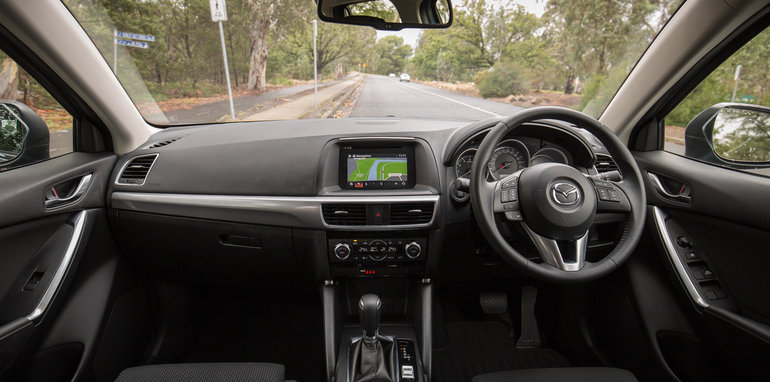

Furthermore, its MZD Connect rotary dial that operates the tablet display is by far the most ergonomic here, the infotainment UX is the simplest to navigate, and the sound system (as checked by our chief technology officer and audiophile, Cam) is easily the best of the bunch.
But the presence of cloth seats bereft of proper bolstering or base length undoes the premium vibe somewhat. The seats are frankly, flimsier and cheaper than what the other pair offer. Which is a real shame, and a good reason to consider the $43,390 CX-5 GT AWD.
The Porsche influence carries over from the Sportage’s nose through to its cabin. Do you think those upright air vents flanking the fascia are just coincidentally similar to a Cayenne’s?


Indeed, the Sportage offers an excellent cabin for the money. Its black leather seats are the best here, given they have the full gamut of electric adjustment and, despite the presence of some hard, cheap-feeling plastics, the overall tactility of the switchgear and most touch points, is superior to the less well-equipped Tucson.
We make particular mention here of the silver-rimmed window switches, the great sports steering wheel, the superior UX from the properly integrated 7.0-inch screen, and the contemporary, less sparse, dash layout. Cam also noted the Kia had the fastest electric windows here — 1.9 seconds to go down. ‘Every last detail’ indeed.
Compared with the Kia, the Hyundai looks austere. And next to the CX-5, it feels less tactile. The giant ‘voice control’ button in place of a sat-nav one, and the sea of black plastics, are notable, though the ergonomics are essentially without flaw. The presence of Apple CarPlay and Android Auto integration is a welcome fillip, though, Apple Maps is no substitute for satellite navigation.


In the rear, the clear winner is the Kia. It’s the only car here with rear air vents, and even offers a rear USB to recharge your phone/tablet. And while it has the fattest C-pillar here, and no third side-window, outward visibility is fine.
All cars here offer ISOFIX anchors, though, only the Mazda has a neater seat-mounted middle seatbelt, unlike the tacky roof-mounted setups in the Hyundai and Kia. On the flip side, the hard plastic seat backs in the Korean brands’ offerings are more child-friendly than the soft cloth setup in the Mazda.
There’s a similar amount of occupant space in the back row, which is to be expected given the equality of dimensions. The Hyundai and Kia share a 2670mm wheelbase, 30mm shy of the Mazda. The CX-5 is also 65-70mm longer and 50mm taller, but widths are about identical.



Pictured above (top to bottom): Mazda CX-5, Hyundai Tucson, Kia Sportage.
In the cargo area, the Tucson wins, with 488 litres expanding to 1478L when the middle seats are folded. The Kia is close, at 466L/1455L, ahead of the Mazda at 403L, which grows to an excellent 1560L.
The Mazda also has the best cargo cover, because it clips to the tailgate, and is the only car with levers in the rear to drop the middle seats (it even drops the 40:20:40 individually), meaning you don’t have to walk around the car to perform this task.
So when it comes to cabin analysis, the Kia and Mazda win again. The Kia offers the best rear seats, and has a more contemporary layout than the Hyundai. The Mazda has the best tactility and feel of quality, the cleverest boot and the greater sound system, but the lack of leather seats (plus the average bolstering) lets the team down.

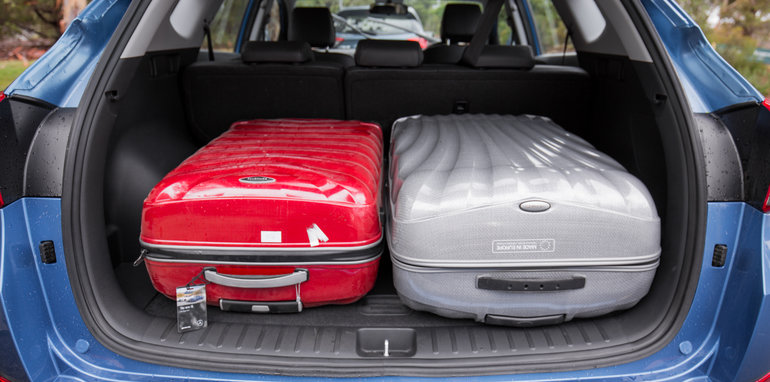
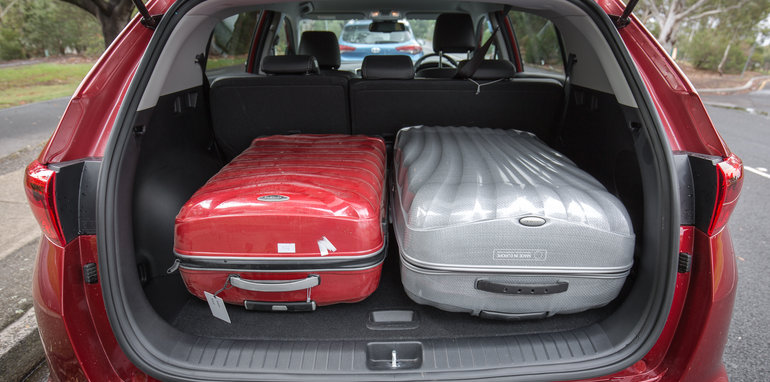
Pictured above (top to bottom): Mazda CX-5, Hyundai Tucson, Kia Sportage.
Drivetrains
Each car here uses a 2.0-litre petrol engine matched to a six-speed automatic transmission, sending torque to the front wheels (front-wheel drive). Let’s be realistic — do you really need all-wheel drive in any of these cars? Rarely.If you really need AWD, only the Mazda at this spec level comes with that option, paired to a bigger 2.5-litre engine for an extra $3000 (this previously said $5000, erroneously). You can get the Hyundai and Kia in AWD, but only in higher spec grades and again, with different engines.
Leading the pack in this test is the Hyundai, with 121kW of power (at 6300rpm) and 203Nm of torque (at 4700rpm). This is ahead of the Mazda with 114kW (at 6000rpm) and 200Nm (at 4000rpm), with the Kia just behind at 114kW (at 6200rpm) and 192Nm (at 4000rpm).



The Mazda (with start-stop) claims the lowest combined-cycle fuel consumption at 6.4 litres per 100km, appreciably better than the other two at 7.9L/100km. In our real-world urban testing the differences between the three were close to this, though each used about 25 per cent more fuel (we weren’t driving in the most efficient manner). All run on cheaper 91 RON petrol.
As the figures suggest, none of these SUVs are speed machines. All feel perfectly adequate punting around the city and at lower speeds, with decent response from their naturally aspirated engines, but feel rather laboured under heavier throttle. In other words, they’re fit for purpose but a touch uninspiring.
As the least powerful car here and the heaviest (at 1606kg kerb), the Kia feels marginally more lethargic than the other two. But in truth, the GDi engine in the Hyundai, despite its extra 7kW/11Nm and 22kg lighter kerb weight to pull about, feels scarcely different to the casual observer.

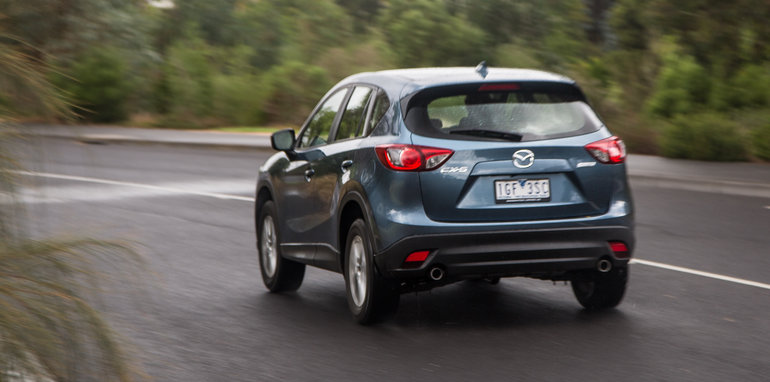
It’s the Mazda that has the edge, presumably because at 1491kg, it’s far and away the lightest car here. It also has that signature annoying SkyActiv (Mazda’s engine family) loud initial idle and tinny note.
But where it wins easily is its superior ‘Sport’ mode (all three cars have a mode that changes the throttle to make acceleration punchier, but the Mazda’s works best), and its brilliantly calibrated six-speed automatic transmission.
It’s the most intuitive here, not that the Kia or Hyundai’s torque-converter units are bad. They’re perfectly fine.
We did basic acceleration tests on each of these cars partially laden, and all measured between 10.5 seconds and 11 seconds 0-100km/h over repeated testing. There’s not much in it.


Ride and handling
So far, then, we’ve seen the Kia and Mazda edge ahead. But now, we’ve found an area where the Hyundai shines.Both the Tucson and the Sportage have Australian-developed suspension tuning, but for ours, the Tucson’s ride comfort is superior. It positively glides over all those road imperfections you’ll find out there, from potholes, to bridge joins, corrugations, cobbles and gravel. There are many, many European luxury crossovers that don’t ride this well.
The Kia, by comparison, feels just a touch harsher on initial impact. Both ride on larger 18-inch alloy wheels, though, neither actually feel it. The Kia is still well ahead of the class average. It just feels a little firmer and a little sportier as it reflects its branding, but is this what buyers want?


The Mazda feels the sportiest here, with a little more steering resistance and a little more eagerness to turn-in (thanks its lighter kerb weight). But all three have excellent body control for SUVs, staying flat in corners. The Mazda is a few decibels louder at a cruise, with some tyre roar sneaking through compared to the other pair.
The reality is, all three ride and handle better than the class average. None have an overly choppy or brittle ride, each steers and handles well, and each has the ability to be both comfortable yet sporty for the class, though, not compared to the average small hatchback of course.
But when you factor in what should be the priorities here, it’s the Tucson that wins, on account of its applause-worthy ride. The others are a little sportier, but that’s not what buyers here want, surely. We’d take any of them over a Toyota RAV4 or Nissan X-Trail in a heartbeat.

Ownership
The Kia wins in terms of ownership. And not just against these rivals. There is simply no car brand with a longer-lasting aftersales program. You get an industry-topping seven-year/unlimited km, fully transferable warranty with roadside assist, and seven years of capped-price servicing covering a period of seven years/105,000km (this is seven services).Sister brand Hyundai offers a very decent five-year/unlimited km warranty and roadside assist. It also offers a fantastic lifetime servicing plan, meaning every Hyundai dealer must charge the same amount for a given interval at a given time, which you can find out on its public website (as with Kia).
The Mazda comes with a three-year/unlimited km warranty. Mazda standard roadside assistance costs $68.10 per year, while its premium roadside assistance adds benefits such as accommodation, a rental car, or vehicle recovery, at a cost of $83.50 per year. It also comes with lifetime capped-price servicing.

Verdict
If you’re determined or limited to spending around $35,000 on a mid-sized SUV for urban use, you won’t do better than this trio. Each offers an outstanding proposition, but there’s a clear order to be found.The Hyundai Tucson Active X rides like a dream, offering supreme comfort, while its cabin is vast and its external design very stylish indeed. But it’s under-equipped and sparse inside compared to the Kia.

The Mazda CX-5 Maxx Sport has the best cabin tactility, interface and sound system. It’s the sportiest in feel here, has the cleverest cargo area and comes available with outstandingly affordable preventative safety features.
But this sales champion is shaded by the new Kia Sportage SLi, though they’re both 8.5/10s. As you step up into higher price brackets, the order will no doubt change. But in this part of the segment, the Sportage offers the best balance between equipment, design and comfort, with the fewest compromises. It also offers the best ownership credentials.

If any of these cars floats your boat more than the other, rest assured that none are bad choices. The Kia for our money would be the best one. But it’s close.
Information boxes
Kia Sportage SLi FWD auto — $33,990
Hyundai Tucson Active X FWD auto — $32,990
Mazda CX-5 Maxx Sport FWD auto — $32,790*
Hyundai Tucson Active X FWD auto — $32,990
Mazda CX-5 Maxx Sport FWD auto — $32,790*
Sportage
SLi |
Tucson
Active X |
CX-5
Maxx Sport | |
Leather seats
|
Yes
|
Yes
|
No
|
Cruise control
|
Yes
|
Yes
|
Yes
|
Keyless start
|
No
|
No
|
Yes
|
USB port
|
Yes
|
Yes
|
Yes
|
Screen size
|
7.0-inch
|
7.0-inch
|
7.0-inch
|
Sat-nav
|
Yes
|
No
|
Yes
|
Apple CarPlay/Android Auto
|
Soon
|
Yes
|
No
|
Bluetooth
|
Yes
|
Yes
|
Yes
|
Climate control
|
Yes
|
No
|
Yes
|
Alloy wheel size
|
18-inch
|
18-inch
|
17-inch
|
Spare wheel type
|
Full-size
|
Full-size
|
Steel
|
Roof rails
|
Yes
|
Yes
|
Yes
|
Privacy glass
|
Yes
|
No
|
Yes
|
Rain-sensing wipers
|
Yes
|
No
|
Yes
|
Parking sensors
|
Front/rear
|
Rear
|
No
|
Reverse-view camera
|
Yes
|
Yes
|
Yes
|
Electric-folding mirrors
|
Yes
|
Yes
|
No
|
Isofix points
|
Yes
|
Yes
|
Yes
|
Daytime running lights
|
Yes
|
Yes
|
No
|
Auto headlights
|
Yes
|
Yes
|
Yes
|
Number of airbags
|
6
|
6
|
6
|
ANCAP rating
|
Not tested
|
5 stars
|
5 stars
|
*Note: The CX-5 Maxx Sport here had the optional Safety Pack fitted, which costs $1230. Adds blind-spot monitoring, rear cross-traffic alert, an auto-dimming rear mirror and low-speed autonomous brakes.
Sportage
SLi |
Tucson
Active X |
CX-5
Maxx Sport | |
Engine
|
2.0 petrol with 114kW (at 6200rpm) and 192Nm (at 4000rpm)
|
2.0 petrol with 121kW (at 6300rpm) and 203Nm (at 4700rpm)
|
2.0 petrol with 114kW (at 6000rpm (and 200Nm (at 4000rpm)
|
Transmission
|
6 AT
|
6 AT
|
6 AT
|
Fuel use combined-cycle 91 RON
|
7.9L/100km
|
7.9L/100km
|
6.4L/100km
|
Front-wheel drive
|
Yes
|
Yes
|
Yes (also available in AWD with bigger 2.5 engine for $3000 more)
|
Length
|
4480mm
|
4475mm
|
4540mm
|
Width
|
1855mm
|
1850mm
|
1840mm
|
Height
|
1655mm
|
1660mm
|
1710mm
|
Wheelbase
|
2670mm
|
2670mm
|
2700mm
|
Cargo capacity
|
466/1455L
|
488/1478L
|
403/1560L
|
Max kerb weight
|
1606kg
|
1584kg
|
1491kg
|
GVM
|
2100kg
|
2090kg
|
1972kg
|
Towing capacity
|
750/1600kg
|
750/1600kg
|
750kg/1800kg
|
Ground clearance
|
172mm
|
172mm
|
150mm
|
Turning circle
|
10.6m
|
10.6m
|
11.2m
|
KIA SPORTAGE BREAKDOWN

MAZDA CX-5 BREAKDOWN

HYUNDAI TUCSON BREAKDOWN

Impressive work—gathering real market data over 3 months from multiple sources gives this retained value research real credibility. It’s especially helpful to see clear distinctions between official distributor cars and AP imports. For anyone serious about smart car buying or selling, check out cartrucksales.your go-to for data-driven insights and honest value comparisons.
ReplyDeleteA lot of car owners don’t know that they can get good money for cars that are no longer running. That’s why I’m sharing this option today. They offer free towing, instant quotes, and pay cash on the spot without making you wait for days. It’s a genuine time-saver for anyone who wants to clear space at home and earn money at the same time. So if you want reliable car removal with zero stress, this service is worth checking cash for cars Sunshine Coast.
ReplyDelete